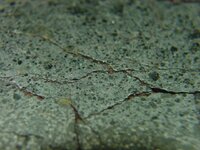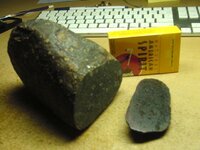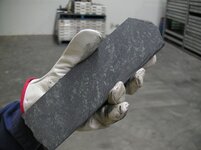ChrisWhewell
Greenie
- Mar 11, 2009
- 13
- 7
- Detector(s) used
- Fisher T-20; White's Coinmaster 1TRDX
Located this in glacial till in Ohio 20+ years ago, among about literally tens of millions of other rocks. Mostly silicates, feldspars, sandstones, etc ranging in size from pebbles to boulders. It has an obvious fusion crust, magnet sticks to it strongly. Ran the detector a long time - very few rocks set it off. This one did. Sliced and polished a section of it, a few shiny specs of metal in it, a grey matrix, some olivine and other silicate domains. I asked a genius professor about it and he said, since it contains no nickel, it can't possibly be a meteorite. So much for geniuses - I replied "Do you mean, everything outside of the earth, every rock floating around in the universe, has nickel in it?" Analysis below, by XRay fluorescence. Notice high terbium content, 10%. No other ore I've been able to locate has 10% Tb. Specimen weighs 2250 grams, so, contains about $100 worth of Terbium. It was evident it came from space - an landed in some sand. The sand had stuck to the silicaceous portions on the outer shell of this rock, becuase it landed in a very hot state and any silica around it would have stuck to those areas. Too bad I knocked them off but parts of the sand are still on the outside. Note also, the presence of Iridium, but no other platinum group metals. This rock has a good story behind it, for the person who knows how to interpret the clues of its composition.
Fe- 70.9%
Ti- 15.0%
Tb- 10.0%
Ca- 2.0%
Mn- 1.2%
Sr- .1%
Zr- .1%
Zn- .1%
Ir- .1%
Si- .008%
Ti- 15.0%
Tb- 10.0%
Ca- 2.0%
Mn- 1.2%
Sr- .1%
Zr- .1%
Zn- .1%
Ir- .1%
Si- .008%
Attachments
Last edited:
Upvote
5








